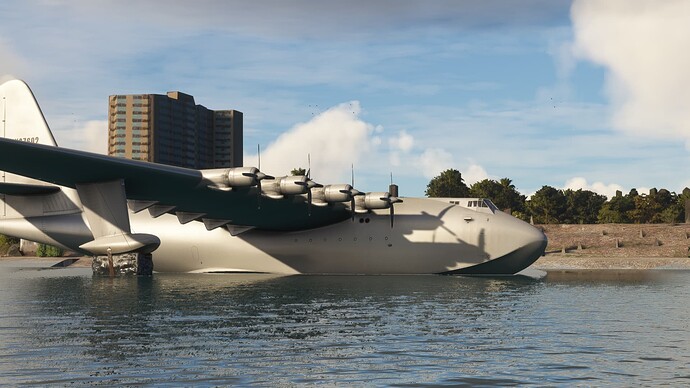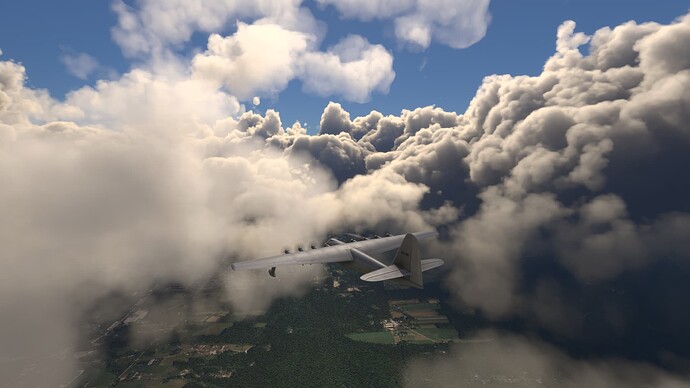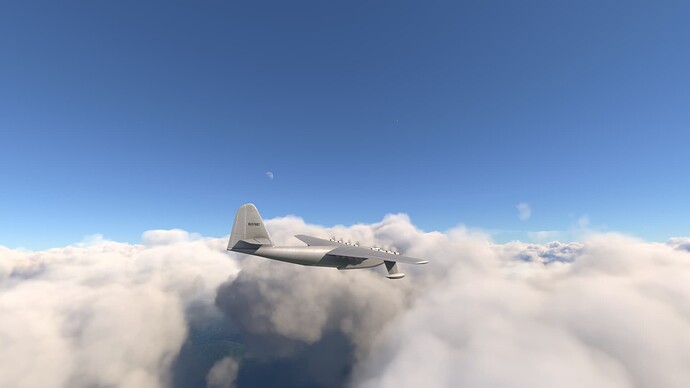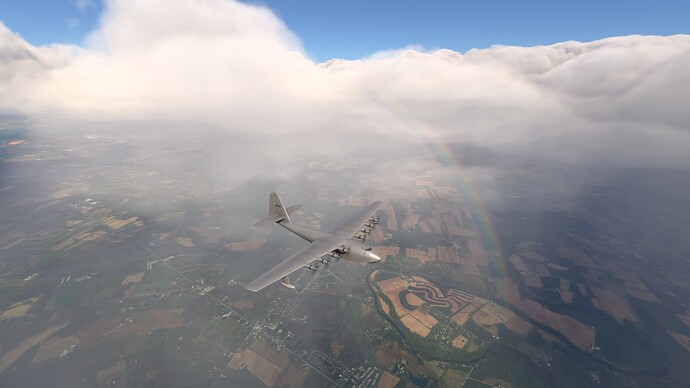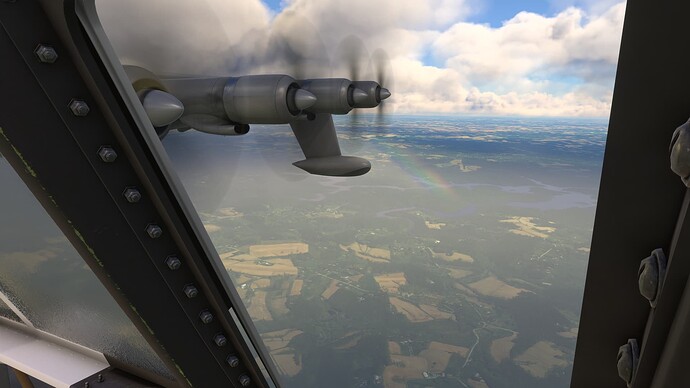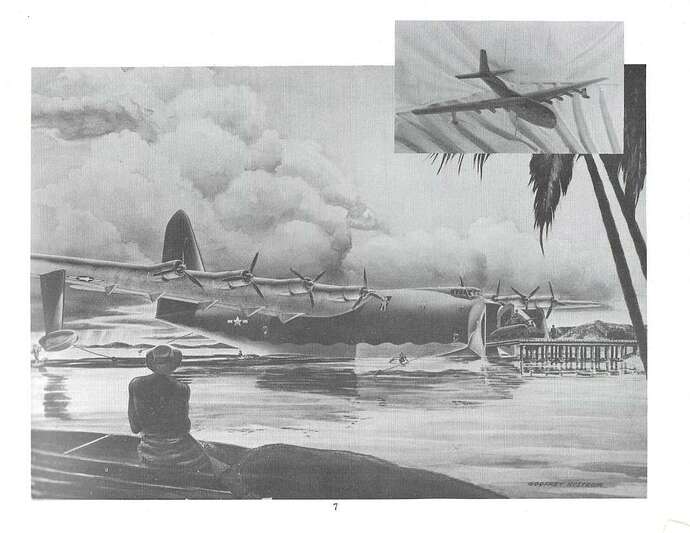Having an issue the left 4 engines won’t run, auto start has no effect on them nether does control+E, the sider for the curtains doesn’t work, and the GPS has no power the other modern avionics seem to have power though.
Thanks.
I ran it just the other day and they all worked fine. It may not have been after the very latest patch though.
I will admit being able to use the tug to move the aircraft, and taxing on engines 4 and 5 makes somethings easier.
Hi all!
I’m starting to really dig into this plane and am having fun flying it. I have a couple of questions:
- Is there a manual; if so, where do I get it?
- How do I adjust the fuel mixture?
- How do I adjust the propeller pitch/rpm?
Finally, what are exit bouys? Even with everything shut down, I don’t think I can see them.
I’m enjoying this plane a lot! It flies well, lands well, and climbs well. I wish the real plane had flown as high and as far as I have flown it in the sim.
I don’t believe there is a manual for the virtual aircraft. There is a later, post flight, manual for the real one in book form if you search for “Spruce Goose Manual”. If you have more specific questions I may be able to help you out. Fuel mixture in the real aircraft was like on a DC-3 with Idle Cutoff, Auto Lean and Auto Rich settings. Auto Rich for everything save cruise where then Auto Lean would have been selected. Automation was a big thing in the aircraft. I don’t think these settings are modeled. If you look at the pilots console to the right and about knee height there is a three way switch. That is your propeller control. The control system for the propellers was pretty cool as it was a semi-automatic system that read off either engine #2 or #3 and then synced all the propeller pitches to that engine. Cool stuff.
Excellent information! Thank you.
So, in the sim, we’re going to assume that the flight engineer is taking care of fuel mixture and we handle the throttle and prop pitch/RPM. I’ll check out that switch when I fly soon.
Many thanks for the help!
Edited to add: I just had a great flight where I adjusted the prop pitch, etc. ![]()
Last question: what are exit bouys? I toggle them on and off on the clipboard, but I don’t think I’m seeing them.
Thanks!
I have a checklist over on flightsim.to if you’d like. It’s a labor of love with most of the information pulled directly from the Flying Boat Manual as best I could with the limitations of the simulator and the aircraft modeled. I think the buoys are your float buoys. They appear with engines off and no speed.
Thanks! I saw a link to the checklist earlier today. It’s on my list to download.
Can you take and post a screen shot of the bouys? I really don’t know what I’m looking for.
I had a great 1.25 hour fllight from New York City to Baltimore this morning. It was very enjoyable.
Here is a shot of the Exterior Buoys. They take some of the load off the floats and support the wings during transport. They can be seen in the move to and from the original dome as well.
Fantastic! I wasn’t even sure what I was looking for.
I got the checklist and think it’s fantastic!
I was surprised to see that cowl flaps are closed for landing. Usually they’re open for radial engines on landing. I’m guessing it’s because these large engines could cool down too quickly at landing engine speeds with airflow going over the cylidners.
Does that sound right to you?
Once I’m at home again I’ll double check in the manual that because I think you’re correct. Glad you liked the CL ![]()
I’ll look to pick up a copy of the manual. I think I saw print copies available for a reasonable price.
Radial engines are interesting. We call them air cooled engines, but actually the fuel going into the cylinders ALSO helped cool them.
And this really blows my mind – it is possible to over-cool radial engines, which causes problems with increased wear and tear and possible engine failure. You’d think the 28 cylinder R-4360 engines would need a lot of cooling, but perhaps they could over cool during landing.
The conundrum of cooling the 3rd & 4th rows of cylinders without over cooling the 1st & 2nd rows in the process.
Exactly! I think those same engines were used in the B-36 and did in fact have cooling issues at first.
This afternoon I did a flight from a seaplane base northeast of Erie, PA to Baltimore Inner Harbor.
Real weather made for some interesting clouds today.
This plane really needs a windshield defroster, though. If there is one, I couldn’t find it.
![]()
So looking at the manual in the Before Landing checklist here are the following steps. Some are for the Pilot (P) and some are for the Engineer (E):
P1 Notify crew to prepare for landing.
P2 Check landing weight and center of gravity.
NOTE: Do not land with center of gravity forward of 26% MAC or aft of 34% MAC
E3 Transfer throttles to pilot’s control
P4 Throttle Transfer switches to PILOT
E5 Oil Flaps AUTO
E6 Carb Air COLD
E7 Mixture RICH
E8 Cowl Flaps CLOSED
E9 Firewall Fuel Valves NORMAL
E10 Booster pumps and Transfer Pumps ON
E11 Emergency Pump OFF
(a) No. 8 emergency tank OPEN
E12 Wing Tanks FULL
P13 Auto Pilot OFF
P14 Auto FT (flying tap) OFF
P15 Flaps - lower as required in increments of 10 degrees.
NOTE: Do not lower flaps above 110 mph (95.5 knots) with power ON or 122 mph (106 knots) with power OFF.
P16 Props 2550 RPM
The first notation on the After Landing checklist is:
E1 Cowl Flaps OPEN
As for icing there is a section on carburetor icing the operation of the engines should it be encountered. A pitot heater is fitted. However I see no evidence of any anti-ice measures towards the cockpit. It should be noted the CAA Flight Restrictions note: The operation of this airplane is restricted by the CAA to visual day contact flights over territorial waters of the United States off the coast of the State of California. Occupancy of the airplane is limited to personal essential to conduct experimental flight tests. No flight is to be conducted for hire or reward.
That’s some awesome information! Thanks.
Hi all,
I’m looking to do another long-ish flight this weekend. What seaplane bases do you use or like? It seems that there really aren’t all that many in the game.
Or, do you not use seaplane bases and just take off of and land on suitable bodies of water?
I Just landed wherever I wanted, although near an airport at Land. And then I saved the position with a tool (I think ist’s called MD adjust aircraft, or similar). Because I liked to start cold and dark. So In the flightplan in the menue I chose a parking position at the airport for the start, but after the start of the sim I changed It to the position of my last flight with the same tool.
That way my flights were totally consistent but startet cold and dark.
